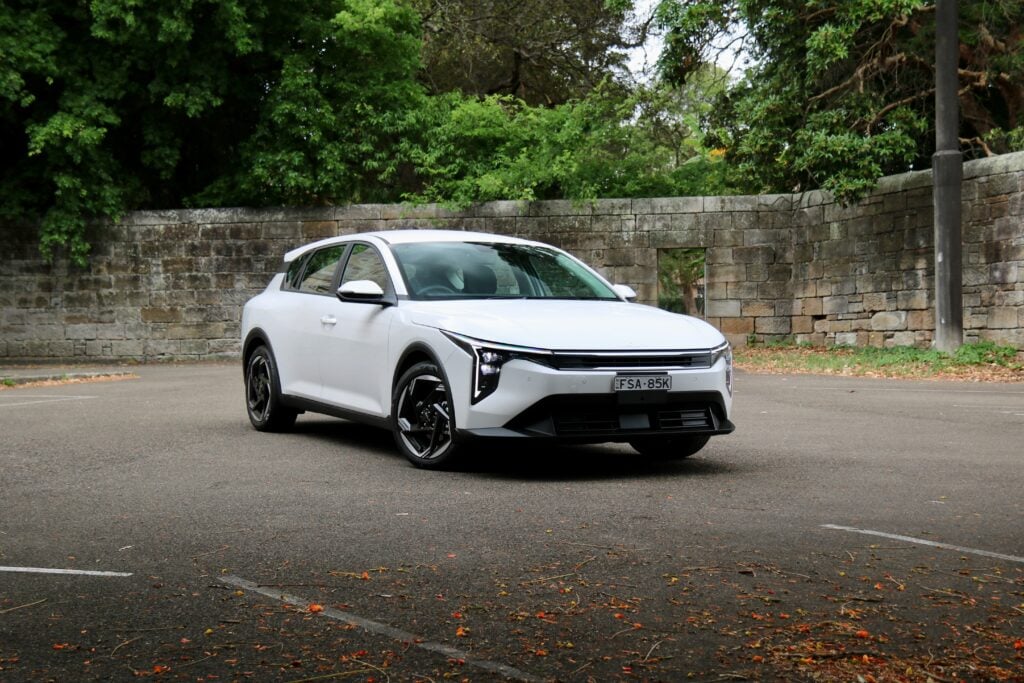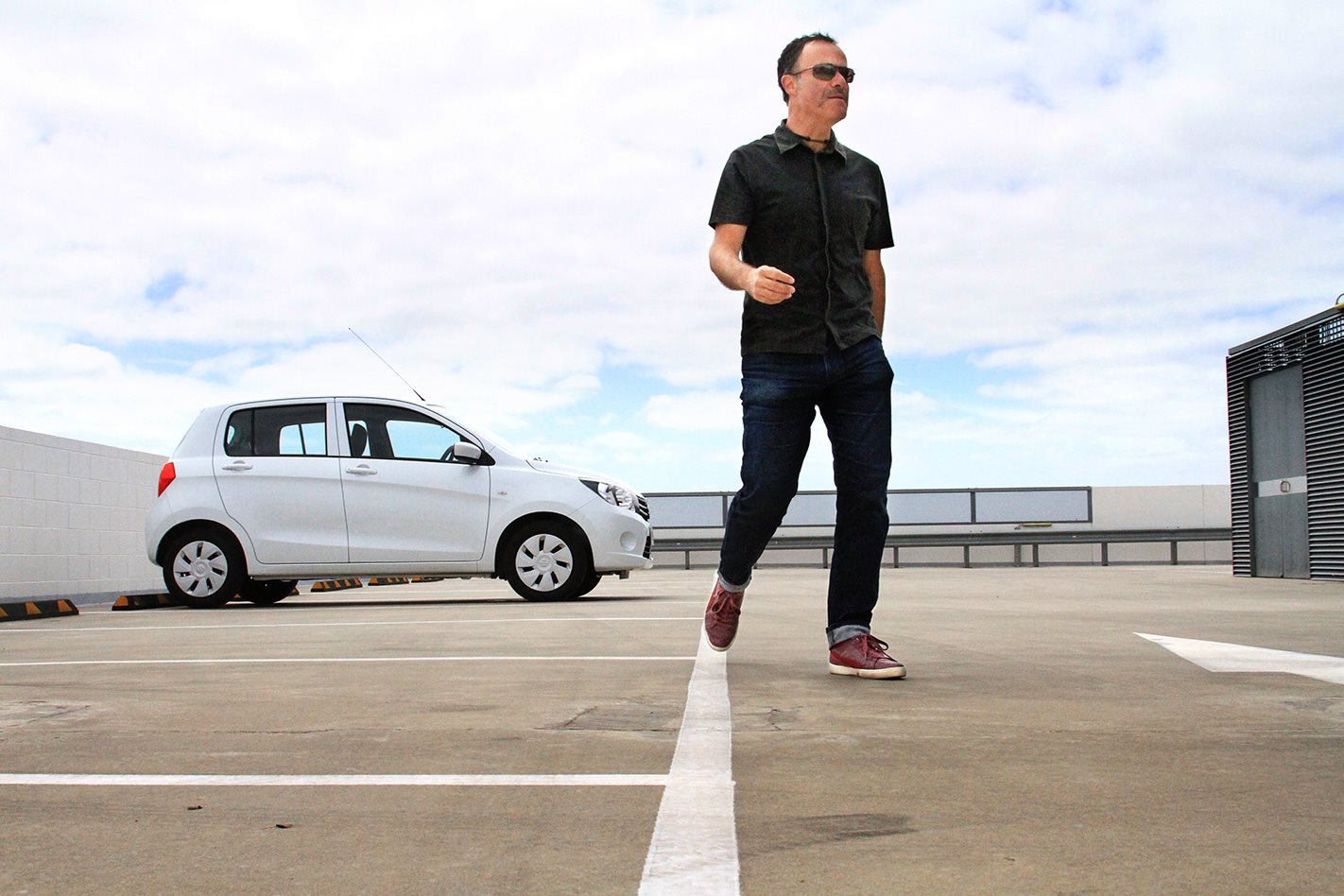
Replacing the Alto, which was built by Maruti of India, the LF-series four-seat five-door baby that comes to us from Thailand may seem like a retrograde step styling-wise, trading its predecessor’s chic design for something that looks somewhat like Chicken Little on wheels. But along the way Australia’s cheapest new car gains a whole lot more beauty elsewhere, thanks to far better packaging, functionality, quality, refinement, safety and – not least – driveability.
Even a brief spin reveals just how far Suzuki’s base hatch has come.
The Celerio – the name combines ‘celestial’ and ‘river’ in Spanish, but we know not why – is 3.6m long by 1.6m wide and an unusually high 1.5m tall, while the 2425mm wheelbase is just 5mm short of the current Suzuki Swift’s. It therefore transcends its class with more than enough space for four adults and a very reasonable 254-litre cargo capacity.
As well as being relatively spacious, the Celerio’s pleasingly presented and finished cabin also offers clear instruments and controls, heaps of storage and even a couple of unexpected items such as Bluetooth audio streaming with track info and steering wheel-mounted phone buttons.
Its vital statistics also include six airbags, stability control, air-con, remote central locking, power windows, height-only steering column adjustment and space-saver spare.
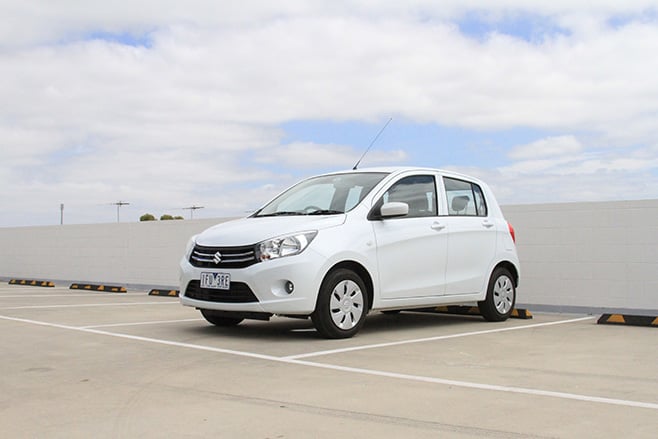
More vitally, a commanding seating position and deep windows make manoeuvring in tight spots simple, the steering is light when parking but firms up reassuringly at higher speeds, and as zesty as the spirited 50kW/90Nm 998cc three-pot is, the chassis feels planted enough to cry out for more power, yet still delivers an outstandingly supple ride.
Obviously, there has been some clever suspension tuning going on. Over its four-year gestation, Suzuki says benchmarks have included the Volkswagen Up, Fiat Panda and Hyundai i10. All are at the pointy end of the sub-B segment in Europe, though none are currently available in Oz, sadly.
So it’s hardly a shock that, considering its price point, the Celerio went on to surprise the hardened judges at COTY, becoming one of the more charming contenders despite its humble station in life. People just assume this is a shitbox until they slip behind the wheel. Just watching their faces light up when they do is rather satisfying.
Indeed, it was during the recent Wheels Car of the Year examination that sub-B fan-boy and Wheels road-test editor Nathan Ponchard agreed to put the Suzuki under the long-termer microscope. We decided to find out if our admiration is a case of just an ordinary car far exceeding initial expectations, or is there still enough substance to see us through living with it for a few months?
We chose the manual because, despite the (completely adequate) CVT version costing just $1000 more, the five-speeder keeps the price at rock-bottom level.
That’s also why we dismissed the $475 metallic paint option, though the Cerulean Blue and Sunshine Yellow really do liven up the palette nicely.
The only option we did ask for – cruise control – is not even available. Nor, for that matter, is Autonomous Emergency Braking. It’s not surprising, therefore, that the Celerio scores only a four-star ANCAP rating, though that’s partly due to poor pedestrian pelvis protection on impact.
The car’s arrival is a timely one because Kia will attempt to shake up the so-called Micro class with the European-engineered Picanto from about April, while a Holden insider has admitted that the Celerio was one of the yardsticks employed for the MP-series Holden Spark that will soon replace the lamentable Barina Spark. A baby battle royale looms…
UPDATE 1
The plan was to take a break from driving new cars…
The holiday season is usually all about minimising family interaction and maximising tinkering time with my long-neglected classics. With an Alfasud recently joining the fold, hands (and credit card) would certainly be kept busy.
Except this time around three friends needed new cars, and pronto. Without warning, Mel’s 2006 Suzuki SX4 met its end in a ditch, Vic’s 2002 Renault Scenic’s electricals expired, and Viv’s decrepit 1992 Camry finally called it a day. Three emergency missions, one plucky Celerio, and no time to lose.
Varying requirements and a vast choice of cars to consider meant a couple of days with each, visiting many different dealerships across the length and breadth of Melbourne. With the air-con cranked up and often all four seats occupied, the Suzuki soon came under the microscope.
First impressions? Everybody commented on how easy it is to get in and out of something so small. All appreciated the light and breezy ambience that the deep side windows so helpfully provide. And nobody complained about the seat cushions, despite initial concerns about them possibly being too flat. In fact, there weren’t any grumbles or gripes at all.
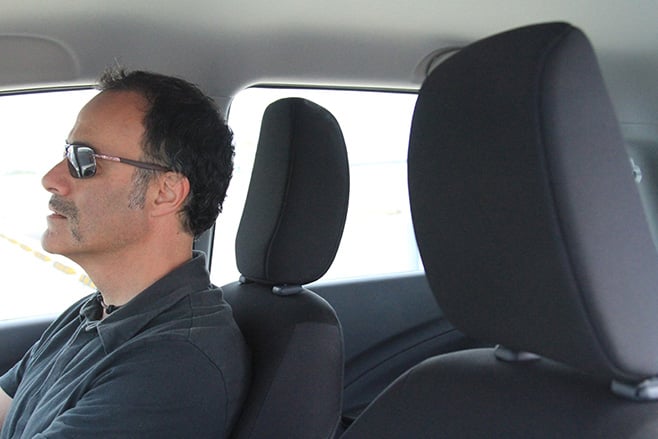
At some stage I had asked each friend how much they thought the Suzuki Celerio cost. All said $15,000. All couldn’t believe it retails for $12,990 driveaway. And one even wondered why she shouldn’t just buy “this little cutie” instead – until she learned it’s only a four-seat city car with limited luggage space.
During this time my already healthy regard for the Celerio kept growing. Even on regular unleaded and with four bodies on board, there was very little noticeable performance drop-off. The steering remained satisfyingly weighted and amply responsive, and the suspension’s ability to absorb bumps and isolate noise is in a higher league than most rivals.
Regardless of all the driving, my sanity prevailed. And that’s telling because shopping for new cars can be stressful and fatiguing. At one point I thought, “This is far closer to a Swift than the Alto it replaced”.
That the Suzuki still felt good even after Mel, Vic and Viv signed away for their respective Skoda Yeti, Volkswagen Golf and Mazda 2 only highlights the pleasing amount of engineering integrity in what is still Australia’s cheapest new car.
Come to think of it, the Celerio is probably a more relaxing holiday proposition than trying to fix non-working tail-lights on an ’82 Alfasud. I ought to be very grateful for my friends.
CLASS OF 91
My previous long-termer, the Peugeot 308 Active 1.2 turbo, was run almost entirely on 98 RON super-premium unleaded, and it consistently returned lower consumption figures as a result. For the Celerio, however, its status as Australia’s cheapest new car dictates that only the least expensive petrol be used – regular 91 RON. That decision was made after the first few tankfuls featured 95 RON premium unleaded. Since then we’ve seen the Suzuki’s average edge up from 5.3 to 5.7L/100km.
UPDATE 2
Byron draws the short straw for a long trip to the ACT. Is the tiny Suzuki Celerio city car up to the cross country challenge?
IT WASN’T much of a vacation at all, not least for the littlest Suzuki, when my geologist partner needed to make a trip to look at, umm, rocks – a 1300km return run to the ACT.
The Suzuki Celerio was not our first choice of chariot, unsurprisingly. After all, it’s not like this little city car is meant for the many rigours of the open-road joust, which often include strong winds and meandering semis driven spare by stupefyingly low speed limits. The tiny Suzi doesn’t even have cruise control as an option.
We need not have worried.
Heaving with geological paraphernalia – tools, flasks, weather-proof (and fashion-proof) clothing, boots and camping gear for two – 1FU-3RE hit the blacktop with quite a burden. Yet the Thai-made tearaway was still strong enough to pull away stoutly from traffic lights, and spirited enough to squirt past slower vehicles as long as there was sufficiently empty road ahead and the driver wasn’t afraid to explore the 6000rpm redline.
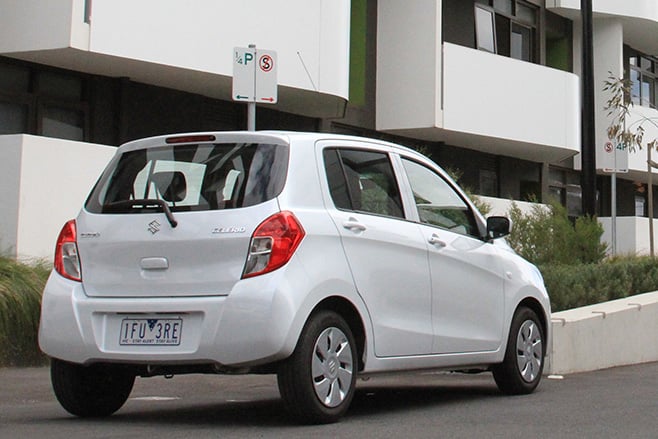
At an indicated 110km/h (actual 103km/h) in fifth, the tacho sat at 3200rpm, yet the 50kW/90Nm atmo triple beavered away with a soothing resilience. While it wasn’t exactly quiet, there was less wind noise than expected, even in quite blowy conditions, while the Celerio was remarkably planted for a car weighing just 830kg unladen; and the ride that has so impressed us around town continued to do so away from the urban limits.
Only two breaks punctuated the run up Highway 31 to Canberra, underlining the fact that the lack of cruise control didn’t bring on right-foot fatigue. And the front seats – even the one occupied by a 200cm human – proved quite resilient in terms of thigh support, dismissing fears that they might be too flat and bum-numbing over longer distances.
Could we drive one of these around Australia? Quite possibly, though the vast glass area probably contributes to the air-con’s reluctance to fully cool the cabin on really hot days, while the clammy plastic steering wheel, more than anything else inside the car, betrays the Suzuki’s bottom-end pecking order.
Furthermore, returning home in heavy rain exposed a lack of sound-deadening; the wheel wells and underbody magnified the wet-road hissing heading south again, which became very tiring after a while.
Still, the Suzuki never raised a sweat during its interstate vacation. While you’d never call it a grand tourer, there’s nothing to lampoon here either. It might even take on a Chevy chase.
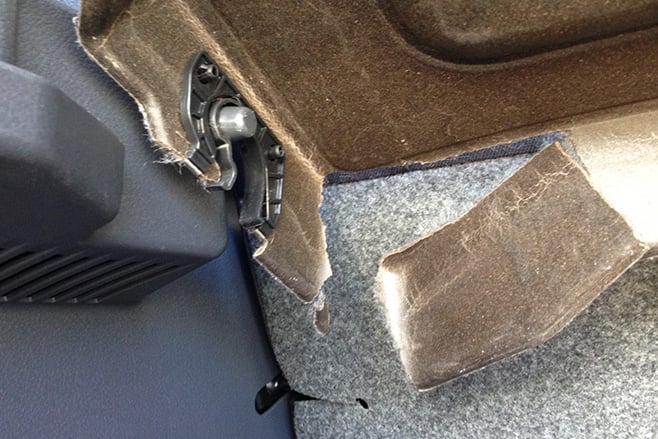
THE BRUNSWICK JOB
In its first three months, our Celerio’s appetite for unleaded has varied between 5.3L/100km (with plenty of highway cruising) and 6.5L/100km, which included heavy urban commuting with at least two additional occupants, and the air-con blasting away constantly. These are some way off the official 4.7L/100km, but the fizzy triple, light gearshift, tight steering and taut yet supple chassis tune encourages enthusiasm. It’s like weaving through Turin in The Italian Job (the 1969 original, of course).
UPDATE 3
We bid farewell to our long-term the Suzuki Celerio, a brilliant value city car that works well in its intended environment.
Seventeen weeks, seven thousand clicks, and across three states in record Aussie summer heat… Is that any way to treat an 830kg four-seat urban runabout?
We did so anyway, and it’s with a heavy heart we bid bye-bye to our $13K-driveaway Suzuki Celerio. For few cars this cheap would still feel cheerful after so much time.
From the post-COTY judging curiosity that sparked us to include the Thai-built sub-B supermini in Garage, through the holiday season, then into the first few months of the year, 1FU-3RE never erred. Unlike the pretty but flawed Suzuki Alto, few corners have been cut to keep the price low.
The Celerio certainly works well in its intended environment. For starters, thanks to some very utilitarian boxiness combined with a substantial 1.5m-high roof, entry and egress is easy.
Once inside, deep side windows, thin pillars and lofty seats help lift the ambience, aided by some unexpected attention to detail. For example, there’s the dotty upholstery, metallic brightwork, elementary Bluetooth set-up with decent audio streaming and wheel-mounted phone buttons, and very ’80s Alfa-style eyeball air-vents.
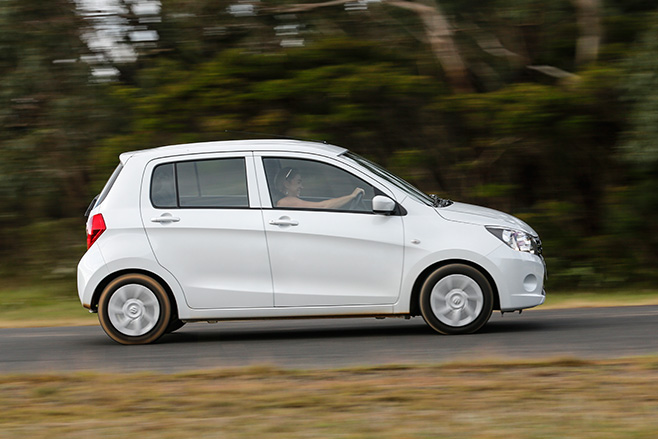
Speaking of ventilation, it is ample, though all that glass does tax the air-con on sweltering days. And a suitable driving position is not difficult to find despite no telescopic steering adjustability, the seats are comfy (they only look flat), the classy if basic instruments are the very definition of clarity, and there’s storage galore.
Importantly, thoughtful packaging equals ample space for four adults, while the sizeable (2425mm) wheelbase also results in a better-than-average 254-litre boot. In fact, the Celerio’s size makes it feel like a car from the class above.
It drives like one, too.
Lusty yet still quite subdued, the 50kW/90Nm atmo triple is quick off the mark, and an intelligently geared five-speed manual transmission makes the most of the 998cc engine’s limited power. The fact it pulls so energetically through the ratios – even when laden for a long highway drive – is testimony to the Japanese brand’s expertise at building such strong and seemingly unburstable engines.
Our Celerio also proved frugal, with the long-term average of 5.6L/100km taking in heavy inner-urban commuting as well as open-road touring. And remember, the air-con was blasting constantly and often there were two people on board.
But the biggest shock came with the Suzuki’s dynamic consistency. While not pin-sharp, the steering feels pleasingly weighted and well connected; the handling is predictable and linear, and it will hang on gamely when pushed despite a tendency to understeer; and the ride is astonishingly absorbent, smoothing out surfaces that agitate most rivals.
Down points? The flimsy cardboard cargo cover tore, so that’s rubbish. The front headrests push too far forward (facing them backwards is the solution). And highway driving in the rain revealed the lack of sound-deadening in the rear underside.
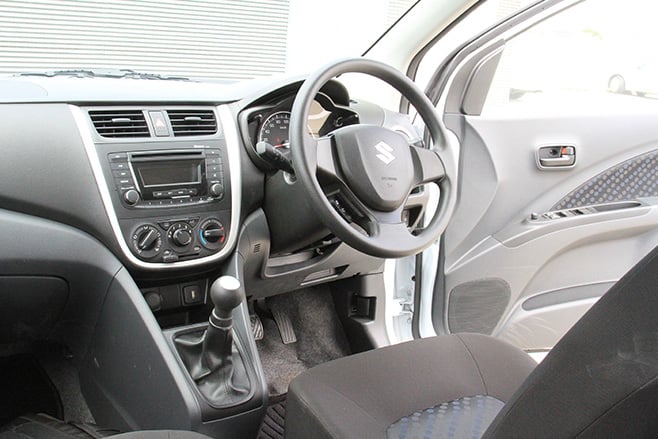
We’d also like to see AEB (even as an option), along with cruise control, but otherwise it lacked nothing significant.
In addition to the mandatory stability control and anti-lock brakes, that sub-$13K driveaway price includes six airbags, air-con, remote central locking, power windows, Bluetooth phone and audio streaming, a height-adjustable-only steering column, space-saver spare and a three-year/100,000km warranty. There are no glaring spec shortfalls.
This neatly sums up the littlest Suzuki after a little more than four months. It may look dowdy to the point of dumpy (especially post-Alto), but the function that trumps that slightly forlorn-looking form is formidable as well as friendly. And the styling definitely improves with exposure.
Even outside its urban comfort zone, the Celerio is a classic case of being more than the sum of its parts.
GET IT INDIA
In emerging markets like India where the roads and environment are challenging, the Celerio is often the sole family car, which necessitates more rear-seat space, greater ground clearance and a beefy torsion-beam rear suspension. Translated to Aussie conditions, these might help explain why the Suzuki takes to our open-road blacktop with surprising ease; this month we tallied 2700km of effortless mostly highway driving in 1FU-3RE without fuss, though we did miss cruise control.
CELERIO VS USED
At the bottom end of the market, a new-car warranty could be the only thing separating the Suzuki from, say, a perfectly functional 2013 Toyota Yaris YR with 60,000km on the odo for similar money. Despite the second-hand alternatives often being slightly larger, with the practicality of five rather than four seats and a more powerful engine, in important ways such as space utilisation, running costs, ride comfort and that intangible joie de vivre, the Celerio puts forward a compelling case.



